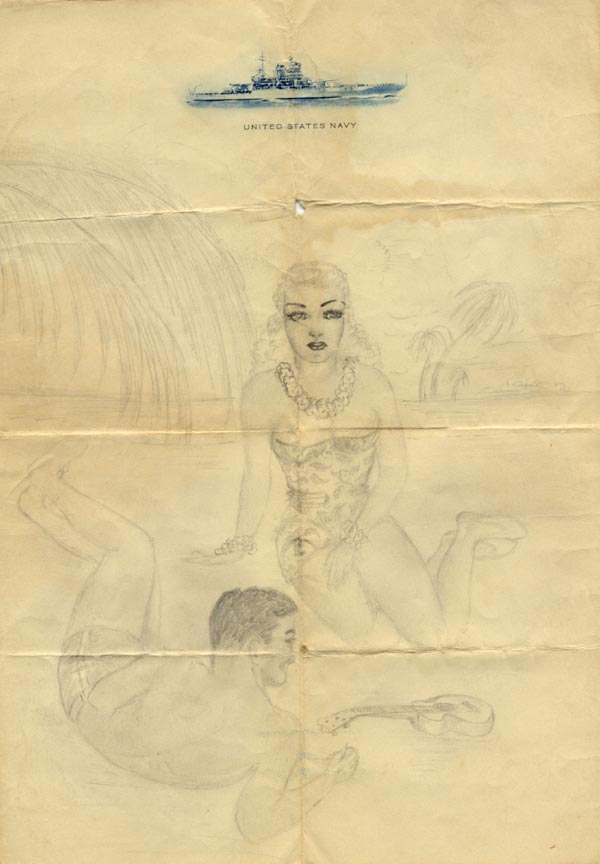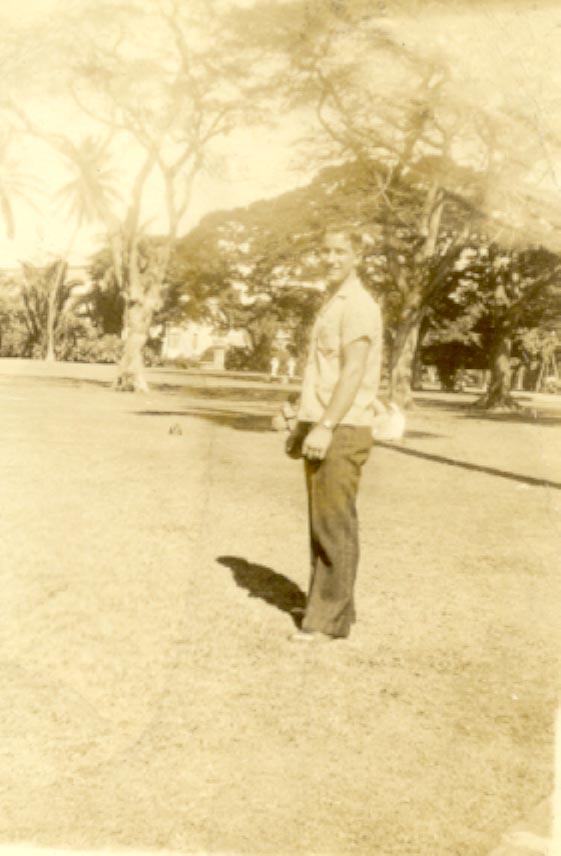
Remember...Thomas Joseph Abruzzino
|
| Tommy attended Washington Irving High School where he was a gifted student and athlete. He was also an excellent self-taught artist. He was known to always keep a steno pad with him, and his talent was easily seen in a sketch he made of a Philippine woman while he was in the service. |  Sketch by Thomas Abruzzino |
 Thomas Abruzzino in Hawaii |
After graduation, Tommy was anxious to learn a trade, serve his country, and see far away places like Hawaii. For these reasons, he enlisted in the United States Navy on December 5, 1938. Tommy never failed to write home and to ask about all the members of the family. He also liked to send gifts, such as a tailor made Navy suit for Anthony and hand-made pillowcases and bedspread for Rose Marie. |
| After his letter of November 12, 1941, Tommy's correspondence suddenly stopped. On March 9, 1942 the Abruzzino family received a telegram informing them that Tommy was missing pending further information. The family eventually learned that Tommy survived the Bataan Death March and spent three years as a Japanese prisoner of war in Bilibid Prison Camp where he and the other prisoners were starved, mistreated, and denied adequate medical care. |  Thomas Abruzzino in San Diego |
 Japanese ship Arisan Maru |
In 1944, the Japanese realized that the Philippines would soon be recaptured by American troops. To save their POWs from being liberated, they decided to move them to Japan for use as slave laborers. Tommy was boarded onto a Japanese ship called the Arisan Maru with 1,799 other prisoners for transport. When this ship left port in October, 1944 it carried no markings whatsoever, so it was easily and legally a target for Allied submarines to torpedo. Thus, in the Bashi Channel in the South China Sea, a US submarine mistook the Arisan Maru as an enemy warship and had no idea it carried US prisoners of war. The submarine torpedoed this ship and all but five of the POWs lost their lives. Some of the prisoners tried to board a Japanese rescue ship, but they were easily beaten off because the Japanese treatment left them too weak to put up any struggle. Tommy was one of the many brave men who lost their lives that day; his body was buried at sea. |
One of the track bosses, a Japanese civilian called 'Pistol Pete' used an iron bar about 1/2 inch in diameter and about 2 feet long to beat prisoners. I watched him break the ribs of one prisoner while beating him with this bar. The prisoner's name was Abrazzino [sic], an Aviation Metalsmith Second Class.*
It is easy to see that Thomas Abruzzino was forced to endure atrocities most people can barely imagine. But his sacrifice was not in vain, for he helped to champion the cause of democracy and protect the freedom of the world. Tommy was posthumously awarded the Purple Heart on behalf of the citizens of a grateful nation. In recognition of his honorable service in World War II, and for his ultimate sacrifice, Thomas Joseph Abruzzino's name is inscribed on the Tablets of the Missing at the Manila American Cemetery in Manila, Philippines, and Thomas's was one of the original names inscribed on the West Virginia Veteran's Memorial. Thomas is also honored on the World War II memorial online registry by his niece, Rosalie Price.
*"Pistol Pete" was really Sergeant Major Mutsuo Okubo, who was charged with five specifications of physically abusing American POWs. The United States Army Judge Advocate General's Corps, War Crimes Branch, tried Okubo and he was found guilty on four of the five charges. Okubo was sentenced to two years of hard labor. The Lochbihler affidavit that mentions Thomas Abruzzino was used as part of this trial record. A copy of the information provided by the National Archives and Records Administration, as well as Chief Petty Officer Lochbihler's affidavit, can be found in the records of the West Virginia Veterans Memorial Archives in the file of Thomas Joseph Abruzzino.

West Virginia Archives and History welcomes any additional information that can be provided about these veterans, including photographs, family names, letters and other relevant personal history.